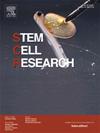一名首发散发性精神分裂症女童的人类衍生iPSC系的产生和特征
IF 0.7
4区 医学
Q4 BIOTECHNOLOGY & APPLIED MICROBIOLOGY
引用次数: 0
摘要
精神分裂症是一种高度遗传性的神经发育障碍。在这项研究中,从一名诊断为首发散发性精神分裂症的女童身上获得外周血单核细胞(PBMCs)。通过引入重编程因子OCT4、SOX2、NANOG、LIN28、c-MYC、KLF4和SV40LT生成诱导多能干细胞(iPSCs)。通过核型和关键多能性标记的表达证实了iPSC系。这些细胞在体内表现出分化为所有三种胚层的能力。本文章由计算机程序翻译,如有差异,请以英文原文为准。
Generation and Characterization of a Human-Derived iPSC line from a female child with First-Episode of sporadic schizophrenia
Schizophrenia is a highly heritable neurodevelopmental disorder. In this study, peripheral blood mononuclear cells (PBMCs) were obtained from a female child diagnosed with first-episode of sporadic schizophrenia. Induced pluripotent stem cells (iPSCs) were generated by introducing the reprogramming factors OCT4, SOX2, NANOG, LIN28, c-MYC, KLF4, and SV40LT. The iPSC line was confirmed through karyotyping and the expression of key pluripotency markers. These cells demonstrated the ability to differentiate into all three germ layers in vivo.
求助全文
通过发布文献求助,成功后即可免费获取论文全文。
去求助
来源期刊

Stem cell research
生物-生物工程与应用微生物
CiteScore
2.20
自引率
8.30%
发文量
338
审稿时长
55 days
期刊介绍:
Stem Cell Research is dedicated to publishing high-quality manuscripts focusing on the biology and applications of stem cell research. Submissions to Stem Cell Research, may cover all aspects of stem cells, including embryonic stem cells, tissue-specific stem cells, cancer stem cells, developmental studies, stem cell genomes, and translational research. Stem Cell Research publishes 6 issues a year.
 求助内容:
求助内容: 应助结果提醒方式:
应助结果提醒方式:


